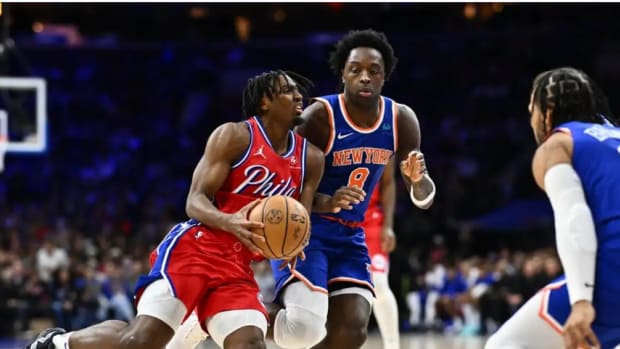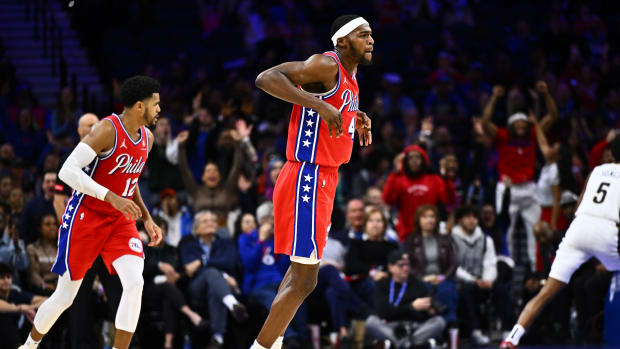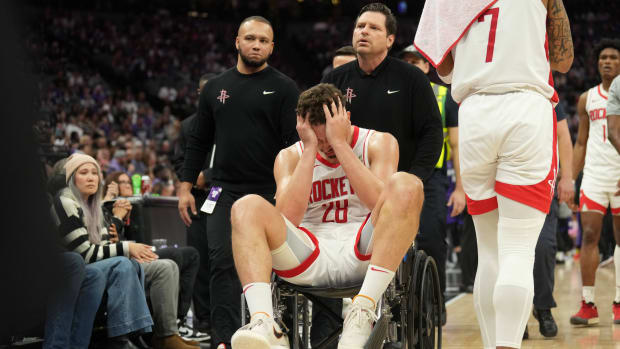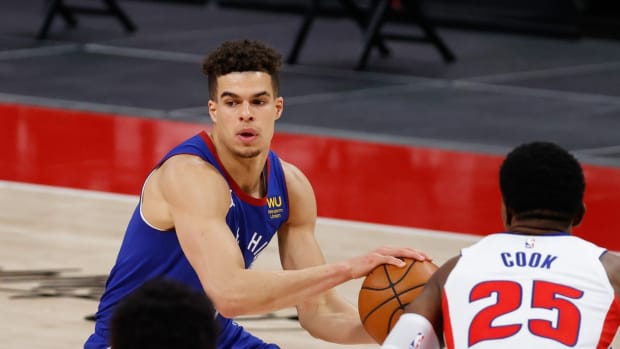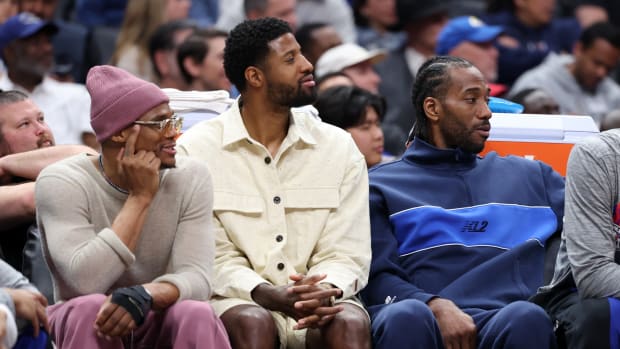Data Dimes: Breaking down the Derrick Rose blockbuster deal
Your teams. Your favorite writers. Wherever you want them. Personalize SI with our new App. Install on iOS or Android.
We haven’t even reached the official start of free agency yet, but trades are already shaking up the landscape of the league.
Moments after a three-team trade between the Atlanta Hawks (Jeff Teague), Utah Jazz (No. 12 pick) and Indiana Pacers (George Hill) was reported, a blockbuster deal by the Chicago Bulls sending point guard Derrick Rose to the New York Knicks rocked the Twitterverse.
The Knicks will also acquire Justin Holliday and a 2017 draft pick, while sending away Robin Lopez, Jerian Grant and Jose Calderon.
Without question, the key piece on the move here is D-Rose. The former MVP is a big name and still just 27 years old, but he’s also entering the final year of his contract and is owed more than $21.3 million in 2016–17.
Derrick Rose's Salary by Season vs. League Average | PointAfter
Using visualizations by PointAfter, a sports data site that’s part of Graphiq, we’ll break down the latest NBA blockbuster with what it means for both teams.
More from PointAfter (Graphiq network): All-Time Rosters for Every NBA Franchise | Re-Picking the 1996 NBA Draft | Ranking the Best MVP Seasons in NBA History
Gambling on a Resurgence
After missing just six games combined throughout his first three seasons in the pros—and taking home MVP honors in 2011—Rose’s remarkably promising career was derailed by injuries.
Derrick Rose: Games Played and Missed by Season | PointAfter
Rose suffered a torn ACL during the 2011-12 season, which caused him to miss the entirety of the 2012-13 campaign. Over the past four seasons, even though he’s stayed relatively healthy of late, Rose missed 201 of a possible 328 regular season contests (more than 61% of games).
Frankly, even when Rose has been out on the court, he hasn’t been close to the same player.
• Rose's legacy will live under LeBron’s shadow | Trade Grade: Who won Rose deal?
The Downfall of MVP D-Rose | PointAfter
The Chicago native has seen his per-game averages dip rather significantly since the barrage of knee injuries. In addition, his efficiency as a scorer has plummeted. Prior to getting hurt, Rose converted 46.4% of his field goals. In his three seasons since returning to the court, he’s shot 41.2% from the field.
The advanced stats have been ugly as well. Over the past three seasons, Rose compiled box plus/minus figures — an estimate of points contributed by a player per 100 possessions — of -5.1, -1.3 and -3.3, respectively. Over the same three-year span, he’s amassed just 1.4 win shares. (For reference, Rose had 13.1 win shares during his MVP season.)
It's become clear that Rose wasn’t a net positive for the Bulls last season—especially on defense.
• SI.com's NBA draft tracker | Trade roundup | Pick-by-pick analysis
Opponent Stats vs. Bulls With and Without D-Rose | PointAfter
Bulls opponents were statistically superior scoring, passing and rebounding when Rose was on the floor. Adding him to the roster while shipping Lopez out projects the Knicks’ roster to have plenty of problems defensively.
This is a dice roll by the Knicks. They’re hoping Rose can somehow experience a resurgence, and while the numbers don’t paint a rosy picture (pun intended), trading for Rose may not be a completely fruitless endeavor. After all, the veteran did round himself into form after the All-Star break.
Derrick Rose's Stats Pre- and Post-All-Star (2015-16) | PointAfter
Rose shot 46.8% from the field and 37.5% from long range after All-Star weekend. He was a far more efficient scorer and drained threes at a clip well above his career average of 30.2%. Of course, his plus/minus and defensive rating both declined during that span as well, so overreacting to the positives would be rather foolhardy.
New York has created its own Big Three with Rose, Carmelo Anthony and Kristaps Porzingis, and while that might be enough to make the playoffs in the Eastern Conference, contending remains a pipe dream.
Even if Phil Jackson goes out and signs a big like Dwight Howard or Pau Gasol, he’ll need some sort of youth serum to return the core to 2011 in order to boast a championship-caliber product.
The Other Side
It couldn’t have been easy for the Bulls’ brass to say goodbye to its native son, but it became an increasingly necessary decision when Chicago failed to even make the playoffs in 2016. The team needs a new look, and while its haul for Rose may not leap off the page, the Bulls added some solid pieces.
Lopez, while certainly not a star, started all 82 games for the Knicks a season ago. He averaged 10.3 points, 7.3 rebounds and 1.6 blocks, and he’s under contract through 2018-19 at approximately $13 million per season. That figure will look cheap as cap figures continue to grow and future contracts become more outrageous.
Additionally, Brook’s twin brother made 53.9% of his shots and was particularly adept when finishing at the rim.
• Trade grades: Thunder send Ibaka to Magic in draft's biggest move
Robin Lopez: 2015-16 Shot Selection | PointAfter
His ability to cash in at the bucket, mix in an array of hook shots with either hand and knock down mid-range jumpers make him a versatile factor on the offensive end, which is more than you can say for guys like Andre Drummond and Hassan Whiteside—both set to make top dollar this summer.
Throw in Jerian Grant on a rookie deal—he’ll make between $1.6 and $2.6 million per season over the next three years—and Chicago added two fairly priced role players for Rose, who was set to come off the books next summer anyway.
It doesn’t seem as though the Bulls are done dealing, but it’s difficult to fault them for agreeing to this trade.
Rose made his mark professionally in the city where he was raised. Now he’ll attempt to do so under the bright lights of New York City.






























